Mikołaja Reja Street in Bydgoszcz
Mikołaja Reja Street is a historical street of downtown Bydgoszcz.
| Bydgoszcz | |
|---|---|
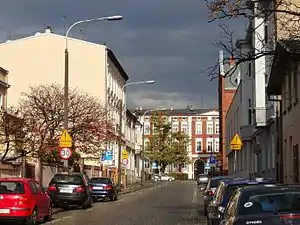 Northward view of Piotra Skargi street | |
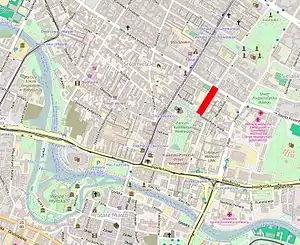 Location of Mikołaja Reja Street in Bydgoszcz | |
| Native name | Polish: Ulica Mikołaja Reja |
| Former name(s) | Gräfe straße |
| Namesake | Mikołaj Rej |
| Owner | City of Bydgoszcz |
| Length | 160 m (520 ft) Google maps |
| Area | Downtown district |
| Location | Bydgoszcz, |
| Construction | |
| Construction start | 1860s[1] |
| Completion | 1872[2] |
Location
This short street, aligned from north to south, connects Piotra Skargi and Zygmunt Krasiński Streets.
History
The street is not mentioned on maps before the second half of the 19th century. Mentioned in a 1855 address book as Grostwo, a Bromberg map of 1876 by Paul Berthold Jaekel features a north-south axis bearing the name Gräfe Straße. On this document, like on other maps, the building of the House for blind children - German: Blinden-Anstalt- appears at the northern tip of the street[3]
Through history, the street bore the following names:
- Until 1859, Grostwo village;[4]
- 1859-1920, Gräfe straße;
- 1920-1939, Mikołaj Rej Street;
- 1939-1945, Gräfe straße;
- since 1945, Mikołaj Rej Street.
Current patron of the street is Mikołaj Rej (1505–1569), a Polish poet and prose writer, politician and musician. He was the first Polish author to write exclusively in Polish language, and is considered with Biernat of Lublin and Jan Kochanowski, to be one of the founders of Polish literary language and literature.
Main edifices
Tenement at the corner with Piotra Skargi Street N°5
1880s[5]
This tenement at then Hoffmann straße 2 was the property of Ms Raaß[6] in 1882, then of Emma Stengert.[5]
None of the original frontage decoration survived. The main elevation is topped by a large triangular pediment. The side facade on Mikołaja Reja street displays a mural painting, "Self-determination" (Polish: Samookreślenie),[7] one of 20 pieces in Bydgoszcz streets.[8]
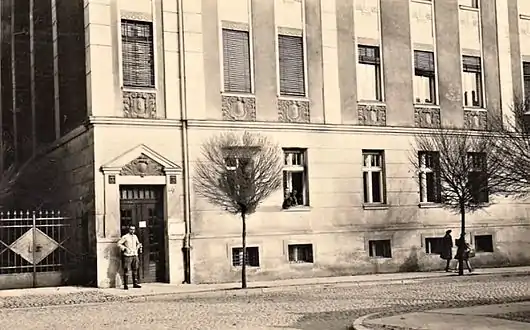 View ca 1945
View ca 1945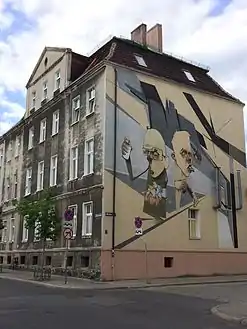 View from the street
View from the street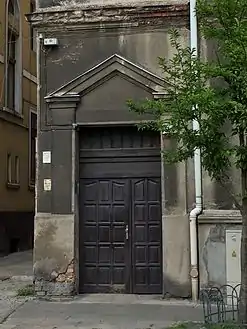 Main gate
Main gate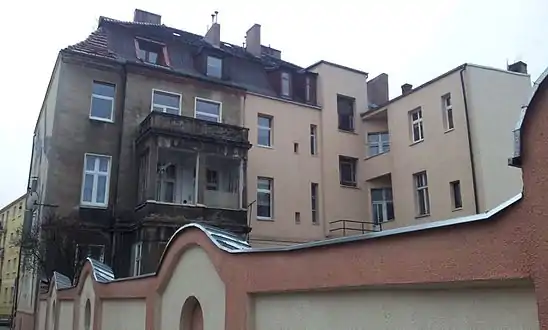 Back view
Back view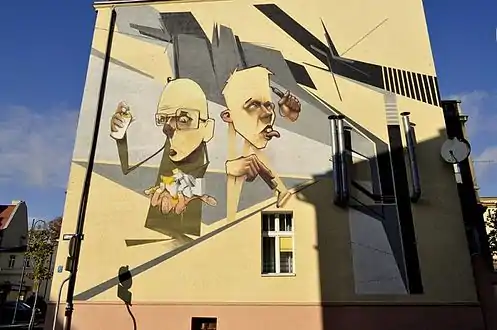 Wall painting at N°5
Wall painting at N°5
Tenement at the corner with Piotra Skargi Street N°7
Early 1880s[9]
Dr Agnes Schulß, a head teacher, was the first landlord of this tenement at then Hoffmann straße 3.[9] She lived there until the end of World War I.[10] It then moved in the 1920s to the hand of Leon Wawrzkiewicz, a manufacturer.[11] Today, the edifice houses, among others, the "Paderewski Music Society in Bydgoszcz" (Polish: Towarzystwo Muzyczne im. I. J. Paderewskiego w Bydgoszczy), a cultural association engaged in the development of music and musical culture in the city.[12] This association organizes every 3 years the "International Paderewski Piano Competition" in Bydgoszcz: the 10th occurrence will happen from 6 to 20 November 2016.[13]
The facade on Piotra Skargi Street is rather common, except some nice palmette motifs inscribed in cartouches. On the other hand, the elevation on Mikołaj Rej street reveals more decorative features with vegetal ornaments and a stylized festoon topped by an oeil-de-boeuf. This side of the tenement gives access to a garden, overlooked by a balcony. The wall of the garden on Mikołaja Reja street displays a mural painting, "Time" (Polish: Czas), by Bezt, Sainer, Pain, Pener, and Autone,[14] one of 20 pieces in Bydgoszcz facades.[8]
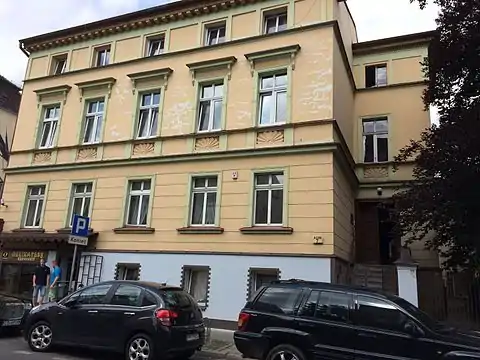 Main elevation from the street
Main elevation from the street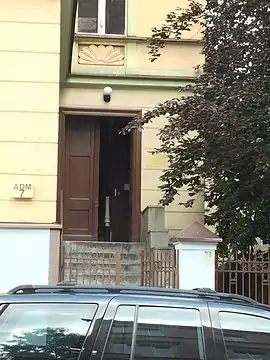 Entry gate
Entry gate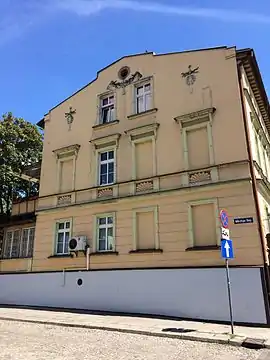 Side facade view
Side facade view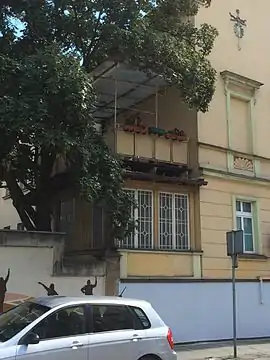 Garden and balcony
Garden and balcony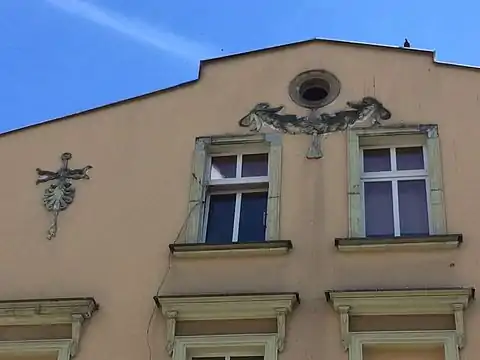 Side facade ornamentation
Side facade ornamentation Mural painting, "Time"
Mural painting, "Time"
House at N°2
1850-1875[15]
The house at then Hoffmann straße 7 was initially owned by Franz Krüger, a carpenter.[16] In the 1920s, the villa was the property of the landlord of the corner house at Piotra Skargi Street N°7, Leon Wawrzkiewicz, a manufacturer.[11]
The house stands out in the street as one of the only villa onto the street, surrounded by higher tenements. One can notice the nicely wood carved motif adorning the outside cross tie beam.
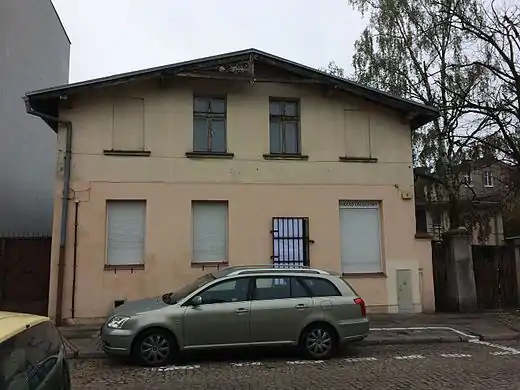 Facade on the street
Facade on the street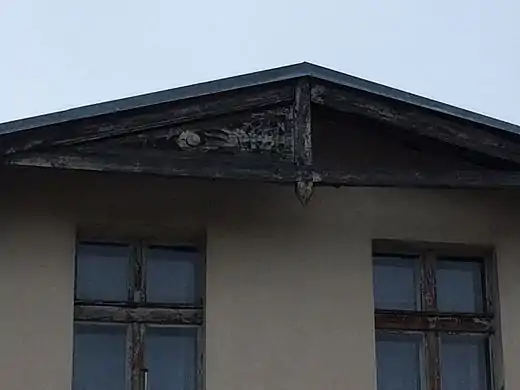 Wood carving detail
Wood carving detail
Tenement at N°3
1878[17]
The house at then Gräfe straße 2 was built for a mason, R. U. Th. Schulße.[17][18] In 1888, it moved to Albertine König, who set up a pension at the place.[19] The facility has been running till 1920 and the return of Bydgoszcz to Polish territory.[20] Today, the edifice houses the seat of the St Peter's and St Paul's parish, which church is located a hundred metres away, on Plac Wolności.
The villa displays a nice wavy gable and a roofed avant-corps onto the courtyard.
 View from the street
View from the street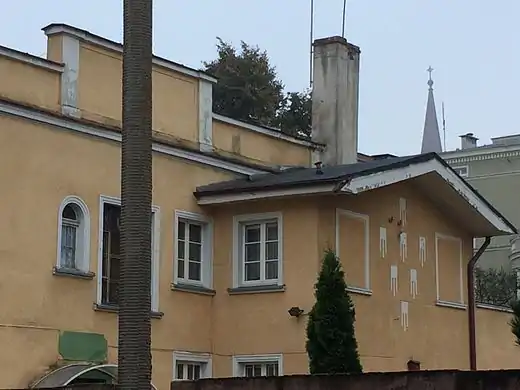 Detail
Detail
Tenement at N°4
1869[21]
Initial address was Gräfe straße 6. Karoline Witt, a widow, is reported as landlord in 1869.[21] In 1883, Wilhelm Kriente, a paymaster, became the new owner;[22] his family lived there until 1920.
The tenement shows Art Nouveau elements, though many motifs disappeared with time. One can underline the two bay windows, topped by eyelid dormers, and the still preserved portal of the main entry adorned by pilasters, transom light and floral ornaments.
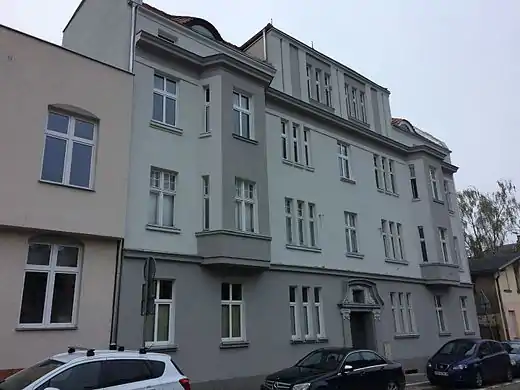 Main elevation on the street
Main elevation on the street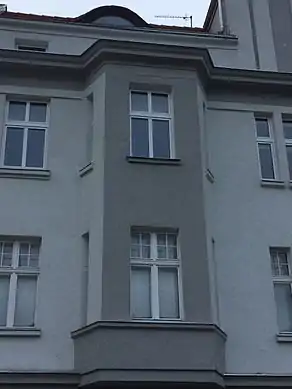 Bay window detail
Bay window detail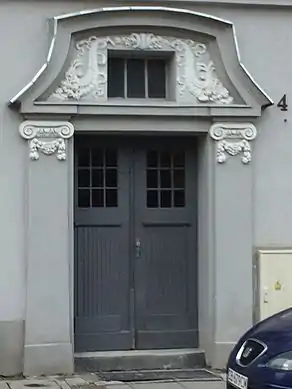 Portal detail
Portal detail
Tenement at N°5
1875-1900[15]
The tenement at then Gräfe straße 3 was first the property of M. Czarnecki, a rentier, who never lived there.[23]
The facade of the building displays typical neo-classical features: simple symmetrical windows, pilasters, pediment and architraves.
 Main elevation on the street
Main elevation on the street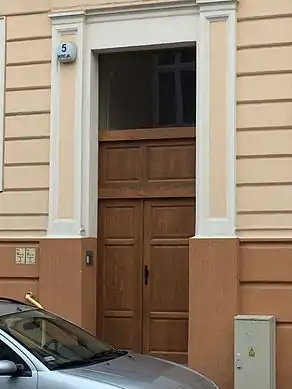 Gate
Gate
Tenement at N°7
1876, 1897
The tenement was initially an educational Centre for deaf children. The first project for deaf children in Bydgoszcz dates back to 1868, when the vice president of the Province of Posen, Karl von Horn, looked to set up such an institution in Bromberg region. First location identified was the Evangelical teacher seminar:[24] it was established in 1871, and provided initially only education, while pupils were living in families.[24]
In 1876, at then Gräfe straße 5, was built a new school,[24] where students could live as in a boarding school, in the premises. The edifice stood next to the L. Braille special educational centre for blind children. From 1890 to 1900, it has been called Provincial Institute for the Deaf (German: Provinzial Taubstummen Anstall zu Bromberg), covering the area of the Province of Posen.[25] In 1911, its names changed to National Institute for the Deaf. In 1922, two years after takeover by the Polish authorities, the school was transferred to Kościan.[25]
The building footprint is L-shaped. Main edifice dates back to 1897: the part giving onto Reja street housed the dormitory. The three-storey wing onto Krasiński Street has been erected in the 1880s. The front elevation presents a small bay window.[25] The school participated to the construction of a brick gym hall (German: Turnhalle), at the corner of streets Krasiński Street and Gimnazjalna in 1896. Today the tenement serves as a residential area. It still boasts -despite a partial rebuilding after 1945- some preserved original woodwork on windows and doors.[25]
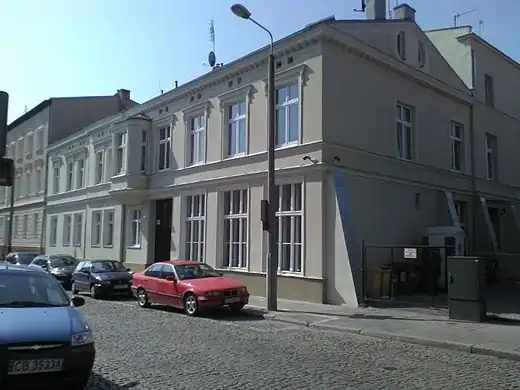 Main frontage
Main frontage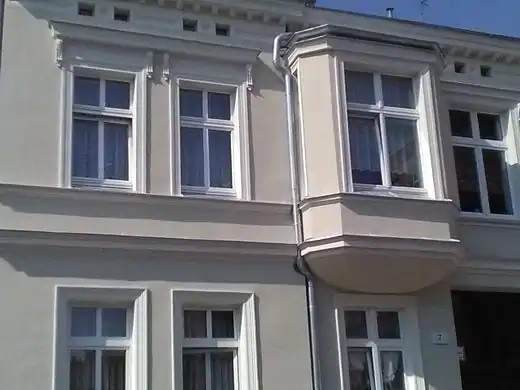
L. Braille special educational centre for blind children, corner with Zygmunt Krasiński Street N°10
1872, Fritz Müller
 View from the street
View from the street
See also
| Wikimedia Commons has media related to Mikołaja Reja Street in Bydgoszcz. |
References
- "Straßen". Adressbuch nebst allgemeinem Geschäfts-Anzeiger von Bromberg und dessen Vororten auf das Jahr 1855 auf Grund amtlicher und privater Unterlagen. Bromberg: Fischer's Printhouse. 1855. p. 59.
- "Strassen". Adressbuch nebst allgemeinem Geschäfts-Anzeiger von Bromberg und dessen Vororten auf das Jahr 1872 auf Grund amtlicher und privater Unterlagen. Bromberg: Mittler's Printhouse. 1872. p. XV.
- Ueberschitsplan der Gemarkjung Stadt Bromberg
- Jehke, Rolf (30 March 2015). "Stadt Bromberg". territorial.de. Retrieved 24 October 2016.
- Adressbuch nebst allgemeinem Geschäfts-Anzeiger von Bromberg und dessen Vororten auf das Jahr 1885. Bromberg: Dittmann. 1885. p. 136.
- Adressbuch nebst allgemeinem Geschäfts-Anzeiger von Bromberg und dessen Vororten auf das Jahr 1883. Bromberg: Dittmann. 1883. p. 90.
- "Mural " Samookreślenie"". visitbydgoszcz.pl. visitbydgoszcz. 2016. Retrieved 18 June 2016.
- "Murale". visitbydgoszcz.pl. visitbydgoszcz. 2016. Retrieved 18 June 2016.
- Adressbuch nebst allgemeinem Geschäfts-Anzeiger von Bromberg und dessen Vororten auf das Jahr 1884. Bromberg: Dittmann. 1884. p. XXIV.
- Adressbuch nebst allgemeinem Geschäfts-Anzeiger von Bromberg und dessen Vororten auf das Jahr 1917. Bromberg: Dittmann. 1917.
- Weber, Władysław (1926). "ulicy". Adressy Miasta Bydgoszczy. Bydgoszcz: Zakłady Graficzne "Bibljoteka Polska" w Bydgoszczy. p. 143.
- "Towarzystwo Muzyczne im. Ignacego Jana Paderewskiego". bazy.ngo.pl. ngo pl. 2016. Retrieved 19 June 2016.
- "International Paderewski Piano Competition". konkurspaderewskiego.pl. The Paderewski Music Association. 2016. Retrieved 19 June 2016.
- "Mural "Czas"". visitbydgoszcz.pl. visitbydgoszcz. 2016. Retrieved 25 October 2016.
- Jasiakiewicz, Roman (24 April 2013). Uchwala NR XLI/875/13. Bydgoszcz: Miasta Bydgoszczy. p. 119.
- "Names". Adressbuch nebst allgemeinem Geschäfts-Anzeiger von Bromberg und dessen Vororten auf das Jahr 1876. Bromberg: Grunauer. 1876. p. 39.
- "Names". Adressbuch nebst allgemeinem Geschäfts-Anzeiger von Bromberg und dessen Vororten auf das Jahr 1878. Bromberg: Grunauer. 1878. p. 107.
- "Names". Adressbuch nebst allgemeinem Geschäfts-Anzeiger von Bromberg und dessen Vororten auf das Jahr 1878. Bromberg: Grunauer. 1878. p. 107.
- "Straßen". Adressbuch nebst allgemeinem Geschäfts-Anzeiger von Bromberg und dessen Vororten auf das Jahr 1888. Bromberg: Dittmann. 1888. p. 29.
- "Names". Adressbuch nebst allgemeinem Geschäfts-Anzeiger von Bromberg und dessen Vororten auf das Jahr 1917. Bromberg: Dittmann. 1917. p. 145.
- "Names". Adressbuch nebst allgemeinem Geschäfts-Anzeiger von Bromberg und dessen Vororten auf das Jahr 1869. Bromberg: Dittmann. 1869. p. 101.
- "Names". Adressbuch nebst allgemeinem Geschäfts-Anzeiger von Bromberg und dessen Vororten auf das Jahr 1883. Bromberg: Gruenauer printhouse. 1883. p. 60.
- "Straßen". Adressbuch nebst allgemeinem Geschäfts-Anzeiger von Bromberg und dessen Vororten auf das Jahr 1880. Bromberg: Miller printhouse. 1880. pp. XX.
- Janiszewska-Mincer, Barbara (1996). Pierwszy ośrodek dla Głuchoniemych w Bydgoszczy. Kalendarz Bydgoski. Bydgoszcz: Towarzystwo Miłośników Miasta Bydgoszczy.
- Umiński, Janusz (2004). Tradycja szkolnictwa dla głuchych. Kalendarz Bydgoski. Bydgoszcz: Towarzystwo Miłośników Miasta Bydgoszczy.
Bibliography
- (in Polish) Denisuk, Andrzej (1990). Z działalności Towarzystwa Muzycznego w Bydgoszczy. Kronika Bydgoska X. Bydgoszcz: Towarzystwo Miłosnikow Miasta Bydgoszczy - Bydgoskie Towarzystwo Naukowe. pp. 205–216.
- (in Polish) Umiński, Janusz (1996). Bydgoszcz Przewodnik. Bydgoszcz: Regionalny Oddział PTTK "Szlak Brdy".
- (in Polish) Pruss Zdzisław, Weber Alicja, Kuczma Rajmund (2004). Bydgoski leksykon muzyczny. Bydgoszcz: Kujawsko-Pomorskie Towarzystwo Kulturalne.
- (in Polish) Przecherko, Tadeusz (2003). Osiemdziesiąt lat minęło. Kalendarz Bydgoski. Bydgoszcz: Towarzystwo Miłośników Miasta Bydgoszczy.
- (in Polish) Janiszewska-Mincer, Barbara (1996). Pierwszy ośrodek dla Głuchoniemych w Bydgoszczy. Kalendarz Bydgoski. Bydgoszcz: Towarzystwo Miłośników Miasta Bydgoszczy.
- (in Polish) Umiński, Janusz (2004). Tradycja szkolnictwa dla głuchych. Kalendarz Bydgoski. Bydgoszcz: Towarzystwo Miłośników Miasta Bydgoszczy.
